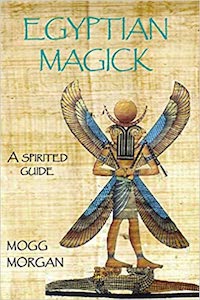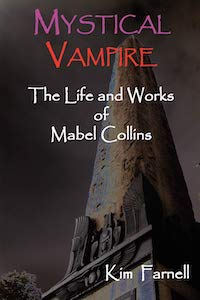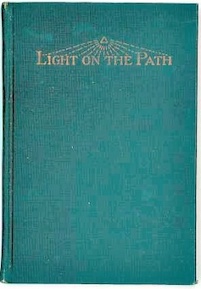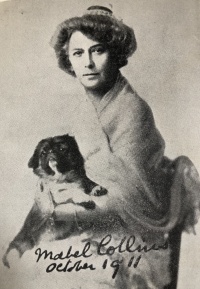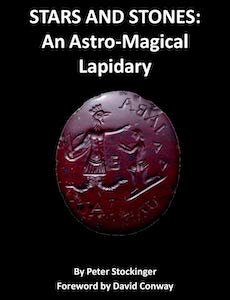
Stars and Stones: An Astro-Magical Lapidary, by Peter Stockinger
Mandrake, 1906958734, 164 pages, May 2016
I recently began a medical astrology herbalism course with Judith Hill and Matthew Wood. As I learn about the physicians of the Renaissance, specifically the way they were all master astrologers, I just discovered in addition to plant remedies, they knew how to use the properties of gemstones to facilitate healing and create magical talismans.
Seeking more information, I turned to Hill’s book Astrology and Your Vital Forces, however the Jyotish description of the use of gemstones wasn’t fulfilling enough for me, as I was hoping to not only to remedy the chart but also use the talismans in my magical workings. Luckily, Stars and Stones: An Astro-Magical Lapidary by Peter Stockinger fills in all the missing gaps I’ve been curious about and truly fits my needs for learning more about this subject.
Written in the introduction, Stockinger’s main reason for writing this book “was to reintroduce the reader to the idea of correspondences and correlations between planets and gemstones.”1 And let me tell you, Stockinger does just this with thorough detail and enough clarification to not overwhelm someone new to this topic.
To begin, Stockinger delves into the planets and their elemental constitutions, which are the foundation of the Universe. Each planet corresponds to one element, and Stockinger provides detail for the attributes of the planet and their element. For instance, Mars is hot and dry, which is attributed to the element of fire.2
The four elements are each associated with a temperament: choleric (fire), melancholic (earth), sanguine (air), and phlegmatic (water). While there have been various methods of calculating a person’s temperament, Stockinger draws from Ferdinand Resberger’s astrological textbook Astronomia Teutsch to teach the reader how to find their own.
This wasn’t the easier endeavour, but after about a half an hour of calculations, I determined all of my temperaments were almost equal, with choleric and phlegmatic having a score of just one higher than melancholic and sanguine. Stockinger made the calculations accessible by clearly starting which zodiac signs correspond to the element or temperament for each stage of the process so one is not having to memorize it all before or consistently reference back to the previous material.
The next chapters are detailed explanations of the planets, zodiac signs, and astrological houses respectively. All the information is the traditional descriptions from Renaissance astrology. I especially enjoyed Stockinger including the diseases associated with the planets and the illnesses associated with the signs of the zodiac. There also are images for all the planets and signs too, which are nice visuals to break-up the dense material.
Additionally, Stockinger includes a list of the body parts associated with every sign and tables of essential dignities and accident dignities according to William Lilly’s Christian Astrology. This introduction concludes Part 1.
Part 2 of the book “Planets, Crystals, Gemstones & Metals” was exactly what I had been looking for in my quest for information. Stockinger sets the stage with a history of the healing properties of crystals and different works about them, such as Abbess Hildegard von Bingen’s Physica and Al Biruni’s Book of the Instructions in the Elements of the Art of Astrology, both published in the 11th century.
“Since the dawn of time, gemstones and crystals have fascinated humans, by their mysterious sparkle, their beautiful colours and their intriguing shapes and symmetries.”3
There is also ample information about the planets and their corresponding metals. Based on the idea that everything emits light when heated, there is a table that shows the wavelengths of color in the visible spectrum. The metals’s emissions spectrum is how the corresponding color is determined. There is ample detail about the correspondence of the seven visible planets, corresponding color, and corresponding metal.
For instance, for the Sun, whose corresponding metal is gold, Stockinger states, “On the physical level, gold helps the body to maintain circulation and it is responsible for the regulation of the impulses in the nervous system.”4 Once again, there is the inclusion of some medical astrology too.
The next chapter, “Planets & Gemstone Remedies,” was my favorite. In this section, Stockinger goes planet by planet giving an extensive overview of each planet (diseases associated with them, corresponding body parts, dignities and disabilities, and more!) and provides gemstones to remedy their effects. For instance, jet and black onyx are recommended to remedy Saturn, while carelin, garnet, haematite, and jasper are prescribed for Mars.
Stockinger provides a detailed history of each crystal and gemstone, along with information about it’s color and hardness. He explains in detail what aspect of the planet the crystal or gemstone remedies and it’s most effective uses. One example is selenite for working with the moon, for it is considered a “holy stone” that helps cleanse and purify emotions.5 It also provides protection against epilepsy and insanity, while repelling negative energies.
Reading through all the crystals of each planet has been immensely useful when deciding which stones to work with in order to produce certain effects. Reading through the case studies in the book helped me to further understand how gemstone can be used to enhance or counter certain energies at play in my astrological chart.
I am looking forward to creating a talisman too from the information I’ve gleaned from this book. Stockinger shares his knowledge on fifteen fortunate fixed stars along with their corresponding sigil (so immensely helpful!), and he shares how to create a fixed star ring for success. He also shares images of the planets and constellations that can be used to enhance a gemstone’s effect, such as a swan for the Cygus constellation and a whale for the Cetus constellation.
Finally, the appendices have a wealth of well-organized content that is immensely useful. There is a Therapeutic Index that has a disease, illness, or circumstance one might want to remedy and a corresponding gemstone, a table of fixed star correspondences, and Agrippa’s planetary glyphs.
All in all, Stars and Stones is a wonderful resource for those interested in learning more about the relationship between astrological energies and crystals, gemstones, and metals. I love how it perfectly blends the stars and earth to facilitate integral healing through one’s chart. I haven’t ever found a book as comprehensive, accessible, or useful as this one on this topic. For those who are looking to incorporate a new dimension into their astrological practice, or perhaps even expand their knowledge of crystals and their healing properties, this is absolutely a book to check out.
Alanna Kali is an astrologer, numerologist, and pioneer spirit that loves to explore life through the lens of depth psychology. She has a passion for studying the humanities and social trends. Her academic work is centered upon reuniting body, mind, and spirit through eco-psychology. She loves reading, spending time in nature, and travel.




